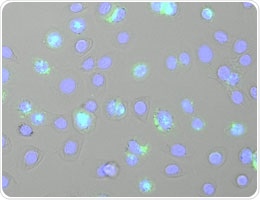A team of researchers, headed by Veit Hornung from Ludwig Maximilian University of Munich (LMU), has demonstrated that a protein present in skin cells detects a particular nucleic acid intermediate that is developed at the time of virus replication. Subsequently, this recognition process triggers a powerful inflammatory response.

A keratinocyte cell line following infection with the Semliki Forest Virus (cell nuclei are shown in blue and double-stranded RNA is stained in green). Image Credit: Stefan Bauernfried.
The capability to distinguish between self and possibly harmful non-self is significant for the survival and integrity of organisms. The so-called innate immune in a majority of the organisms system is responsible for detecting such intruders. Among the numerous proteins that conduct this activity is a class called inflammasome sensors.
As soon as these sensors are activated, they form inflammasome complexes that subsequently stimulate a range of inflammatory responses that can, in certain cases, cause the death of the infected cell.
The research team, headed by LMU immunologist Veit Hornung, along with collaborators from the Technical University of Munich and the Max Planck Institute for Biochemistry, has recently demonstrated that one such sensor present in skin cells directly attaches to a particular molecular structure that emerges during the replication of specific RNA viruses. The latest findings highlight the significance of epithelial cells as an obstacle against invasive pathogens.
The first inflammasome sensor to be found and characterized was the NRLP1 protein.
However, up to now it had remained unclear whether NLRP1 really functions as a direct sensor for non-self molecules.”
Veit Hornung, Immunologist, Ludwig Maximilian University of Munich
In human beings, the NLRP1 protein is mainly found in cells known as keratinocytes, which make up the external layers of the skin and act as a physical obstacle against viruses and bacteria.
The authors of the latest study initially tested how such cells respond to viruses that vary in their replication modes, and found one—Semliki Forest Virus (SFV)—which robustly activated the NLRP1 protein.
Other cells known to have barrier functions, such as cells of the bronchial epithelia, also responded to this virus by activating NLRP1, so this seems to be a general phenomenon.”
Stefan Bauernfried, Study Lead Author, Ludwig Maximilian University of Munich
Initially detected in Uganda, SFV acts as a handy experimental model in virology. While it is predominantly found in rodents, it can also be transmitted to human beings by mosquitos. SFV is known to be a single-stranded RNA virus, that is, its genetic material enclosed in the virus capsid contains a single RNA strand.
But the virus replication process involves the synthesis of a complementary strand, which binds with the parental strand to form a double-stranded RNA. The development of double-stranded RNAs as replication intermediates is typical of several viruses.
However, such structures do not usually take place in the cells of higher organisms, which render them good candidates for detection by the inherent immune system. Biochemical experiments indeed verified that the NRLP1 protein attaches particularly to double-stranded RNA.
This type of sensor is difficult to work with, because they have a tendency to form aggregates. Nevertheless, we were able to purify an NLRP1 construct, and we went on to show that is directly binds to and gets activated by double-stranded RNA.”
Stefan Bauernfried, Study Lead Author, Ludwig Maximilian University of Munich
Taken together, the results indicate that the NLRP1 protein is a major factor in the detection of viral infections in the skin and other similar barrier tissues. It may be especially significant for detecting viruses that are not optimally acclimatized to the potential host.
Whether, and to what extent, the NLRP1 protein is also involved in the identification of other viruses, which are pathogenic to human beings, still remains elusive.
“It’s not altogether unlikely that well-adapted viruses have acquired the ability to inhibit this particular response mechanism. But that’s an issue which we intend to explore in future studies,” concluded Hornung.
Source:
Journal reference:
Bauernfried, S., et al. (2020) Human NLRP1 is a sensor for double-stranded RNA. Science. doi.org/10.1126/science.abd0811.